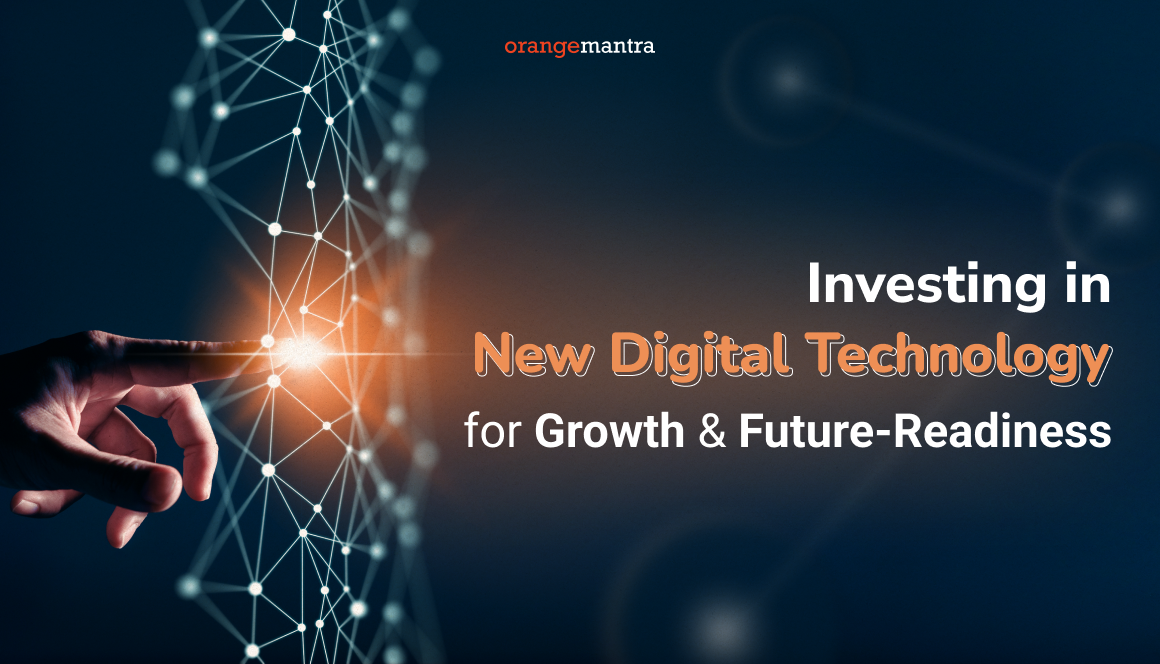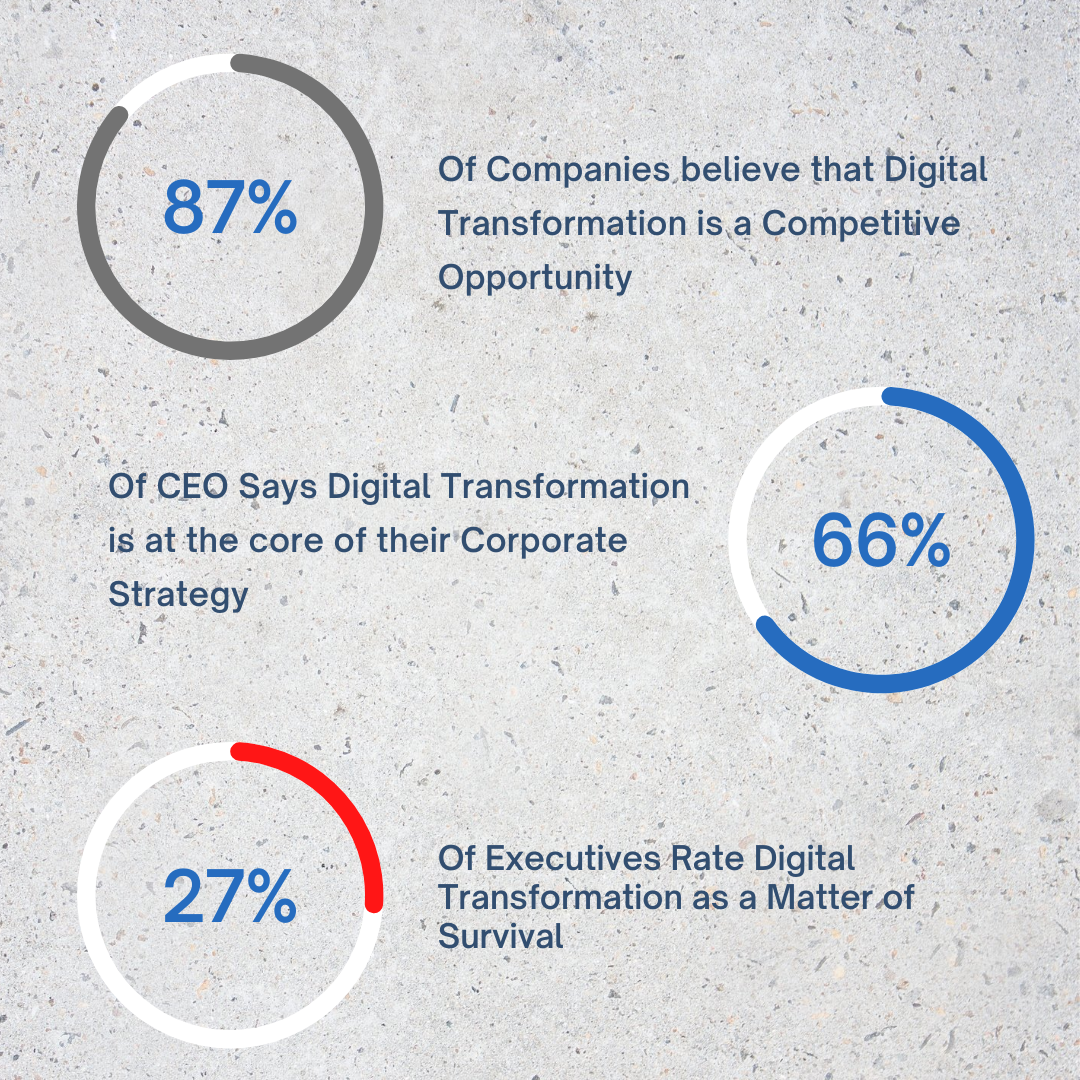Digital transformation of enterprise is at the forefront and poses a way to foresee growth ahead. Still, in some of the companies, C-suite is of the perception of inviting risk factors with substantial changes. It’s not surprising that factors like cost and availability of skilled workforce, stall the pursuit of embracing digitization. However, the upper echelons should be convinced on the ground of, “digital transformation is less about investing into technology, but more about adapting to digital future that depends on next-generation skills.”
With the arrival of the pandemic, the adoption of digital technologies sped up by several years. And the digital-driven trends are likely to be here for the long haul. However, for many business leaders, adopting the facets of digital investment seems like bearing an additional burden of cost. They have the misconception of seeing new technologies as a framework to the core operations. Rather than being essential, they see it as more of a trending over-spending.
Such high-scale echelons of enterprises are not aware of the millennials already investing in technology. Moreover, rather than just a trend, it appears more a necessity to scale up, become hybrid, and omnipresent.
Thus, it becomes all the more imperative to convince business leaders to sign-up for digital transformation services. Concerning this, we share the way out to discuss with leaders to take a plunge into digital transformative and accelerated agility. Most importantly on the grounds of:
* Increasing revenue
* Business driving data
* Resistance to change
* Overcoming psychological barriers
Read on to broaden your perspectives about investing in new technology.
“When digital transformation is done right, it’s like a caterpillar turning into a butterfly,” said Principal Research Scientist at the MIT Sloan Initiative on the Digital Economy,” said the thought leader George Westerman. “But when done wrong, all you have is a really fast caterpillar.”
How to Convince Business Leaders to Invest in Tech
-
Showing Leaders the Revenue-Generation Prospects
As per the recent prediction, the overall spending in the IT industry will see an upscale increase of 6% i.e., by 3.7 trillion this year. So, it could be one of the convincing ways to change the mindset of business leaders.
The increasing rate of ROI is what a majority of C-suite is most interested in. Such decision-makers are the busiest of individuals within the organization. In reality, they do not have time to look into the very process of digital transformation of business. But when it comes to enriching the enterprise’s revenue to an optimum extent, leaders are the ones keen to know the process. Thus, try a straight approach of adding some sense to increasing more numbers in the company’s revenue.
Follow the steps to convince your board and executives:
* Showcase the current market analysis.
* Let them know what the competitors are doing at present.
* Give examples of how digital transformation helps their enterprise to enrich growth and revenue.
* Discuss the impact of digitally-driven initiatives on customer experience, operations, processes, employees, and other aspects.
* Explain how digitization plan overcome cost factor and increase operational efficiency.
* Determine how you plan to measure your success and behavior.
* Create 4-5 years of growth prediction plan for the enterprise.
-
Building Data-Driven Enterprises
Keep that in mind, while convincing your leaders, “Digitize is not just to survive,” it’s more than that. Some companies consider digitization as an optional approach to be ready for the unprecedented time. While your leaders should be convinced more in sense of acceleration, scaling up, and making digital technology the evolutionary change for business to thrive & grow more.
To give a better rundown on this, do refer to the most relevant digital transformation data gathered from various sources.
* The global digital transformation market is projected to grow from $469.8 billion in 2020 to $1009.8 billion by 2025.
* Digitally transformed organizations are projected to contribute to more than half of the global gross domestic product (GDP) by 2023.
* 55% of startups have already adopted a digital business strategy
* 38% of traditional businesses have adopted a digital business strategy
* 89% of enterprises are planning to adopt or have already adopted a digital business strategy
* The implementation of digital technologies can help accelerate progress towards enterprise goals such as financial returns, workforce diversity, and environmental targets by 22%
* The top technologies already implemented include big data/analytics (58%), mobile technology (59%), and APIs and embeddable tech (40%)
* 70% of organizations consider their CEO’s practical understanding of new technologies as adequate or above average.
* 28% of chief information officers and 23% of chief executive officers are either owning or sponsoring digital transformation initiatives.
* 39% of CEOs have placed digital transformation as the top priority for their CIOs.
* 67% of CIOs said creating new revenue-generating initiatives is among their job responsibilities.
* 40% of executives reported that the top benefit of digital transformation was operational efficiency, while 36% said it was a faster time to market.
(Source: https://financesonline.com/digital-transformation-statistics)
-
Mitigating the Resistance to Change
It is a fact that all the unrest from a pandemic, economical to political, small, and mid-size enterprises accustomed to change. They are not reluctant to embrace new processes or tools, as a matter of survival and growth. However, the top flux of businesses still maintains the status quo. Most of the time, they are gripped with the behavior of hassle factor, which prevents them to see the worth in investment. And consider the digital adaptation more of a potential risk for the organization.
However, this particular notion needs to be changed. Top leaders entailed understanding that constant approach to change. They need not feel trepidation about the upcoming impact of digital transformation. But focus on substantial results ahead, just like the competitors are experiencing for quite some time now.
-
Overcoming Psychological Barriers
Sometimes the rational approach is not good enough to convince the budget holders of enterprises to embrace digital transformation. You need to follow a concrete set of convincing options to let them shift their mindset to the long-term effects of digitization.
One way is to showcase the growing acceptance and enhanced ROI of competitors using a digital approach. The other way around is to play on the core facets of human programming like the fear of missing out. It could be related to highlighting the cost of inertia.
Instead of throwing a bunch of advertisements to business leaders about the key benefits of availing digital transformation services. Talk more in terms of the overall impact of their vertical and let them imagine a scenario of adopting a particular technology.
Concluding Thoughts
Turn over the skepticism of business leaders into a profitable need to embrace the digital transformation of the enterprise. Let them understand the vital result of technically disrupting operations and processes. Incorporate digital tools or infrastructure to strengthen the backbone of the enterprise. In doing so, OrangeMantra, a leading digital transformation, and business acceleration company provides end-to-end technical support.
FAQs
- What Are the Four Main Areas of Digital Transformation?
Digital transformation is the seamless integration of digital technologies into all areas of businesses. It can fundamentally change the enterprise’s status quo and makes it more effective and extensively present across diverse areas. In relation to the same, the four main areas of digital transformation are:
* Business Process
* Business Model
* Domain
* Cultural/Organization
- What Are the Main Components of Digital Transformation?
There are three major building blocks of digital transformation of enterprise:
* Customer Understanding
* Top-Line Growth
* Customer Touch Points
The above-mentioned factors are responsible for transforming the customer experience while understanding the requirements and fulfilling the same digitally.
- What Does the Digital Transformation Strategy Include?
Convincing a business leader to embrace digitization in business depends on manifold factors. It also comprises discussing the end-to-end strategy that includes the following key points vision creation, market analysis, experience design, and infrastructure adjustments.


























